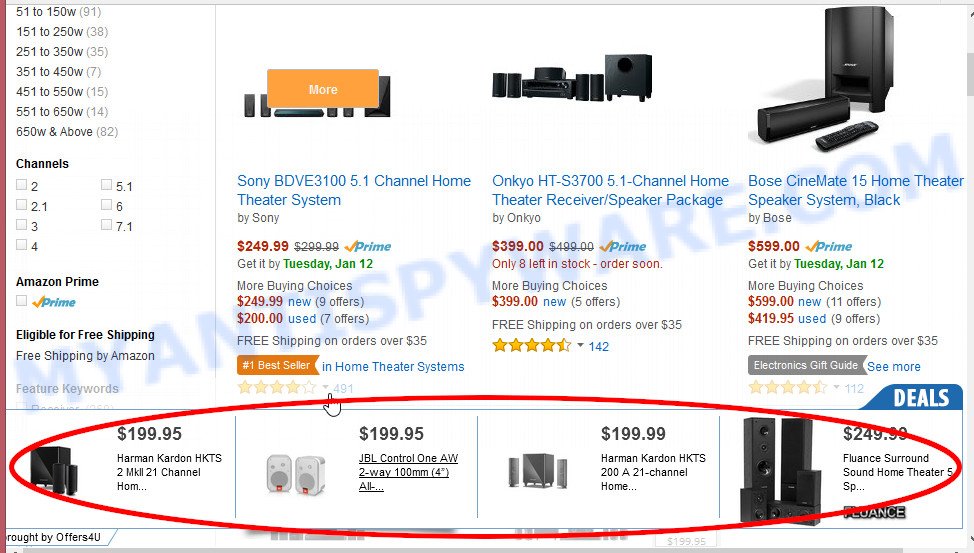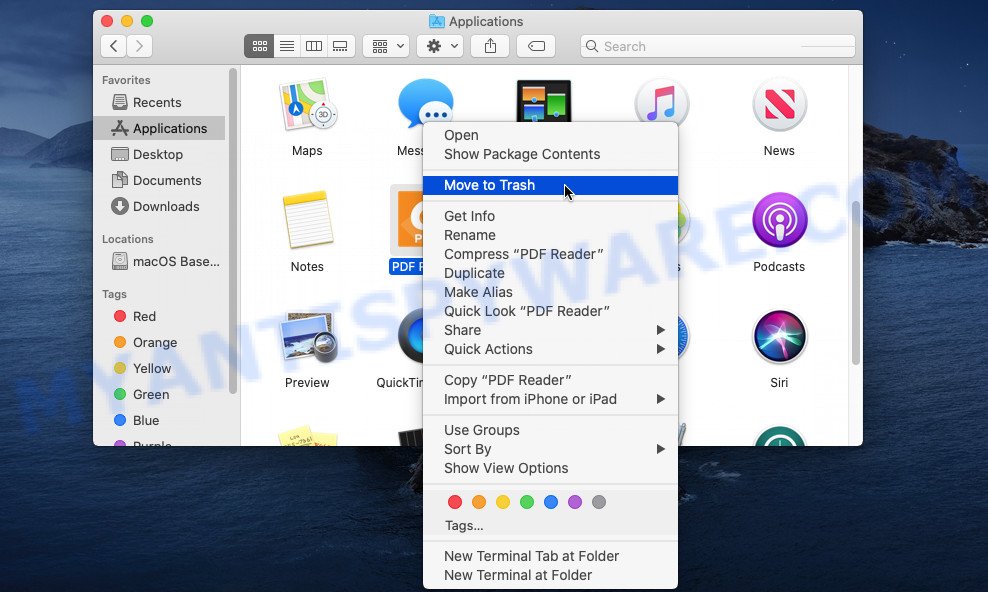What is WebsyncSearch
According to security professionals, WebsyncSearch is a potentially unwanted program (PUP) that belongs to the Adware family . Adware is something which designed in order to provide third-party ads to the user without asking his permission. Adware software takes control of web browsers and redirects them to unwanted web-sites and online ads every time you surf the Web. Adware can end up on your computer in various methods. Most commonly is when you install freeware and forget to uncheck the box for the optional programs installation.

Unwanted ads
The worst is, adware can install a component that enables its author to track which web pages you visit, which products you look at upon those pages. They are then able to select the type of advertisements they show you. So, if you had adware on your machine, there is a good chance you have another that is gathering and sharing your confidential data with third parties, without your consent.
Therefore it’s very important to follow the few simple steps below without a wait. The step-by-step instructions will assist you to remove WebsyncSearch as well as clean your web browser from unwanted advertisements. What is more, the guide below will help you delete other malicious software like unwanted toolbars and browser hijackers that can be installed onto computer along with the adware software.
How does WebsyncSearch get on your computer
Many of the free programs out there install unwanted web-browser toolbars, hijackers, adware and potentially unwanted applications along with them without your knowledge. One has to be attentive while installing free software in order to avoid accidentally installing bundled apps. It’s important that you pay attention to the EULA (End User License Agreements) and select the Custom, Manual or Advanced installation type as it will typically disclose what optional software will also be installed.
Threat Summary
| Name | WebsyncSearch |
| Type | adware, PUP (potentially unwanted program), popups, popup advertisements, pop up virus |
| Symptoms |
|
| Removal | WebsyncSearch removal guide |
How to Remove WebsyncSearch (removal tutorial)
The following guidance will help you to remove WebsyncSearch from the Chrome, Safari and Mozilla Firefox. Moreover, the instructions below will help you to remove malicious software, browser hijackers, potentially unwanted programs and toolbars that your machine may be infected. Please do the tutorial step by step. If you need help or have any questions, then ask for our assistance or type a comment below. Certain of the steps below will require you to exit this web site. So, please read the few simple steps carefully, after that bookmark it or open it on your smartphone for later reference.
To remove WebsyncSearch, use the steps below:
- Remove unwanted profiles on Mac device
- Check the list of installed apps
- Remove WebsyncSearch related files and folders
- Scan your Mac with MalwareBytes
- Remove WebsyncSearch from Safari, Chrome, Firefox
- How to stay safe online
- To sum up
Remove unwanted profiles on Mac device
WebsyncSearch can make changes to the Mac system such as malicious changes to browser settings, and the addition of malicious system profiles. You need to check the system preferences, find and remove malicious profiles and ensure your settings are as you expect.
Click Apple menu ( ![]() ) > System Preferences.
) > System Preferences.

In System Preferences, select Profiles. if there is no Profiles in the list of preferences, that means there are no profiles installed on the Mac computer. If there is Profiles in the list, then click on it, then select a profile associated with WebsyncSearch.

To delete a malicious profile, click on the minus button ( – ) located at the bottom-left of the Profiles screen.
Check the list of installed apps
Some of PUPs, browser hijackers and adware can be removed using the Move to Trash utility which is located in the Finder. So, if you are running any version of Apple Mac and you have noticed an unwanted application, then first try to remove it through the Finder.
Open Finder and click “Applications” such as the one below.

You will see a list of apps installed on your computer. We recommend to pay maximum attention to the program you installed last. Most likely, it is the WebsyncSearch adware. If you are in doubt, you can always check the application by doing a search for her name in Google, Yahoo or Bing.

When the program which you need to remove is found, simply right press on its name, and choose “Move to Trash”.
Don’t forget, choose Finder, then “Empty Trash”.
Remove WebsyncSearch related files and folders
Now you need to try to find WebsyncSearch related files and folders, and then delete them manually. You need to look for these files in certain directories. To quickly open them, we recommend using the “Go to Folder…” command.
Click on the Finder icon. From the menu bar, select Go and click “Go to Folder…”. As a result, a small window opens that allows you to quickly open a specific directory.

Check for WebsyncSearch generated files in the /Library/LaunchAgents folder

In the “Go to Folder…” window, type the following text and press Go:
/Library/LaunchAgents

This will open the contents of the “/Library/LaunchAgents” folder. Look carefully at it and pay special attention to recently created files, as well as files that have a suspicious name. Move all suspicious files to the Trash. A few examples of files: search.plist, WebsyncSearch.plist, com.machelper.plist, installapp.plist and macsearch.plist. Most often, adware software, browser hijackers and potentially unwanted programs create several files with similar names.
Check for WebsyncSearch generated files in the /Library/Application Support folder

In the “Go to Folder…” window, type the following text and press Go:
/Library/Application Support

This will open the contents of the “Application Support” folder. Look carefully at its contents, pay special attention to recently added/changed folder. Move all suspicious folders to the Trash.
Check for WebsyncSearch generated files in the “~/Library/LaunchAgents” folder

In the “Go to Folder…” window, type the following text and press Go:
~/Library/LaunchAgents

Proceed in the same way as with the “/Library/LaunchAgents” and “/Library/Application Support” folders. Look for suspicious and recently added files. Move all suspicious files to the Trash.
Check for WebsyncSearch generated files in the /Library/LaunchDaemons folder
In the “Go to Folder…” window, type the following text and press Go:
/Library/LaunchDaemons

Carefully browse the entire list of files and pay special attention to recently created files, as well as files that have a suspicious name. Move all suspicious files to the Trash. A few examples of files to be deleted: com.search.plist, com.installapp.plist, com.WebsyncSearch.plist, com.macsearch.plist and com.machelper.plist. In most cases, adware, PUPs and browser hijackers create several files with similar names.
Scan your Mac with MalwareBytes
We advise using MalwareBytes to scan the Mac for browser hijackers, PUPs and adware. This free utility is an advanced malware removal program created by (c) Malwarebytes lab. This program uses the world’s most popular antimalware technology. It is able to help you remove malicious software and other security threats from your Mac computer for free.
Click the following link to download the latest version of MalwareBytes for Mac.
21175 downloads
Author: Malwarebytes
Category: Security tools
Update: September 10, 2020
When the downloading process is done, close all software and windows on your computer. Run the saved file. Follow the prompts.
The MalwareBytes Free will automatically start and you can see its main screen as shown on the screen below.

Now click the “Scan” button to perform a system scan for the WebsyncSearch adware software. This task can take quite a while, so please be patient. When a threat is detected, the number of the security threats will change accordingly. Wait until the the checking is done.

Once MalwareBytes has finished scanning your MAC system, MalwareBytes will open a list of detected items. Make sure to check mark the threats that are unsafe and then press the “Quarantine” button. The MalwareBytes Free will get rid of WebsyncSearch adware and move the selected threats to the Quarantine.
Remove WebsyncSearch from Safari, Chrome, Firefox
This step will show you how to remove malicious add-ons. This can remove WebsyncSearch and fix some browsing problems, especially after adware software infection.
You can also try to remove WebsyncSearch by reset Google Chrome settings. |
If you are still experiencing issues with WebsyncSearch adware removal, you need to reset Firefox browser. |
|
How to stay safe online
The AdGuard is a very good ad-blocking program for the Chrome, Firefox and Safari, with active user support. It does a great job by removing certain types of annoying ads, popunders, popups, intrusive new tabs, and even full page advertisements and web page overlay layers. Of course, the AdGuard can stop harmful websites automatically or by using a custom filter rule.

Installing the AdGuard is simple. First you will need to download AdGuard from the link below. Save it directly to your Microsoft Windows Desktop.
3888 downloads
Author: © Adguard
Category: Security tools
Update: January 17, 2018
When the download is complete, run the downloaded file. The “Setup Wizard” window will show up on the computer screen.
Follow the prompts. AdGuard will then be installed. A window will show up asking you to confirm that you want to see a quick guidance. Press “Skip” button to close the window and use the default settings, or click “Get Started” to see an quick instructions which will assist you get to know AdGuard better.
Each time, when you start your MAC, AdGuard will start automatically and stop undesired pop-ups, block harmful and misleading web pages.
To sum up
Now your MAC OS should be free of the WebsyncSearch adware. We suggest that you keep AdGuard (to help you block unwanted popups and unwanted malicious web-pages) and MalwareBytes Free (to periodically scan your MAC OS for new adwares and other malware).
If you are still having problems while trying to delete WebsyncSearch ads from the Firefox, Safari and Chrome, then ask for help here here.

















